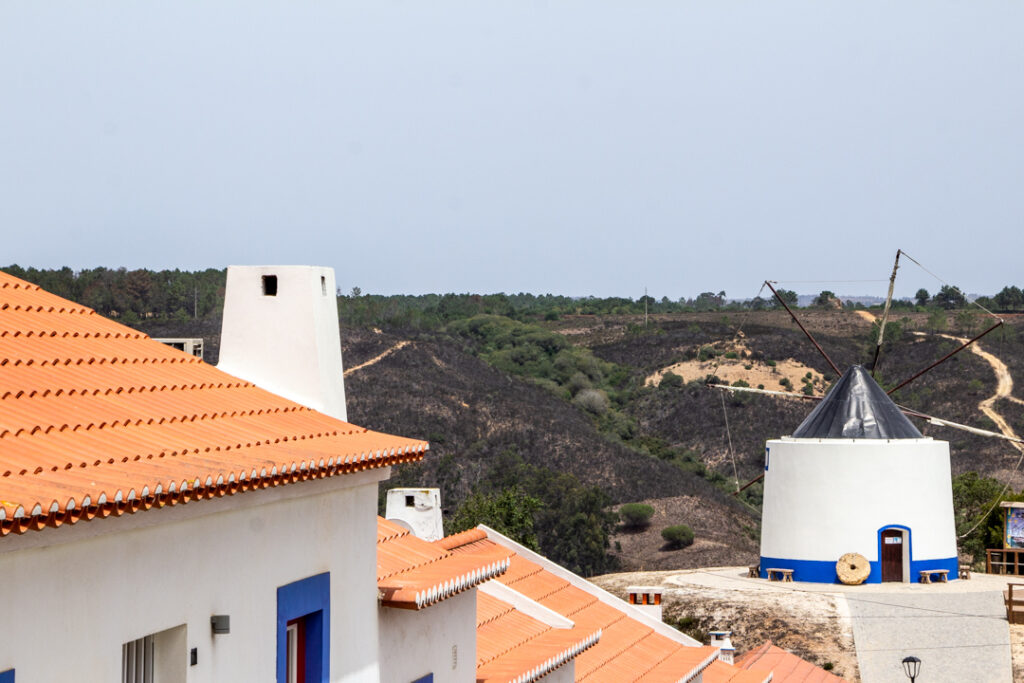The lack of vegetation on the slopes surrounding the village of Odeceixe and the possible dragging of materials in the event of rain is one of the main concerns of Aljezur Council, a month after the fire that affected the municipality.
The fire, which broke out in Odemira (Alentejo) and later spread to Aljezur and Monchique (both in the Algarve), reached the entire surrounding area of the Algarve village and affected the Seixe stream, now putting at risk the “sustainability” of one of the main “tourist products” of the county, councilor António Carvalho told the Lusa agency.
When taking stock of the effects of the fire, António Carvalho explained that, after assisting people who suffered immediate losses due to the fire, the Chamber is now faced with “increasing requests” for support to clean up affected land, with the landscape, sustainability and soil containment are some of the main concerns.
“The rains can bring an additional problem here, mainly because the slopes are all bare and some have some debris resulting from the fire”, he explained, warning that, in the case of intense rains, wood or stones could be carried to Odeceixe, for small settlements, such as Galé de Baixo, and the Seixe stream itself.
As for the damage, the councilor who holds, among others, the Environment department, recalled that the calculation is taking place until the 12th of September and there are still no exact numbers, but said he was aware that at least five affected houses were under analysis. , although none of the first dwelling.
"We have some Local Accommodations and, so far, as far as I know, only two were affected, one on a larger scale than the other, and then there is a lot of damage in terms of what agriculture is", said the councilor of that Algarvian Chamber.
With regard to agriculture, the mayor pointed out the existence of damage with the destruction of "irrigation pipes, fences and electric fences, water tanks and some equipment to support livestock", but without quantifying.
The cattle feed was, shortly after the fire, distributed to the affected producers, so the situation is stabilized, he noted, noting that beekeeping was also affected, with “huge hives destroyed”, with more “muscular” measures being studied to support the activity.
António Carvalho indicated that the Aljezur Chamber and other authorities are preparing interventions to stabilize the slopes, such as the “placement of nets in some places” on National Road 120 “to contain the fall of stones” and prevent some from reaching “housings”. or vehicles that are located next to a parking lot at the foot of these slopes”.
However, he noted, the greatest damage is actually the vegetation cover and the landscape, which “was affected in one of the areas that is a 'hotspot' for nature and identity tourism” in the territory, stressing that Odeceixe and the Seixe stream are a business card for the municipality and the effects of the fire could threaten the sustainability of tourism in the near future.
António Carvalho considered, however, that the fire and its effects also brought an “opportunity to correct some of the bad practices of recent years in forest management” and the Seixe stream.
This stream, he pointed out, should have served to contain the fire, but it turned out to be a driver of the fire because it was not properly treated, nor clean and the “brambles and invasive [species] like reeds were driving the fire along the stream”.
“And this is a concern that remains on the table, especially for the future”, he acknowledged.
The mayor of Monchique, Paulo Alves, said that the fire “did not have a major impact” on the agricultural level in the municipality, “there being nothing significant that could be subject to the aid announced by the Government”.
According to the mayor, around 360 hectares of woods and eucalyptus trees burned in the municipality, "according to the first survey carried out by the municipal services, agricultural holdings were not affected".
“We are finalizing the assessment in order to determine damage to the forest, but it will not be significant compared to the damage in the municipalities of Aljezur and Odemira”, he pointed out.
According to provisional data, the fire that broke out on 11 August in the Alentejo municipality of Odemira and spread to the Algarve neighbors of Aljezur and Monchique, devastated an area of around 8.400 hectares.
In a perimeter of 50 kilometers, the flames affected agricultural and tourist farms, mainly in the municipalities of Odemira and Aljezur, having in Monchique destroyed about 350 hectares of bush and forest.



















Comments